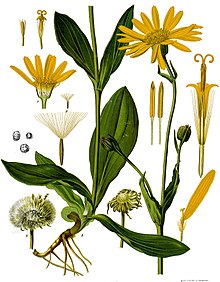Arnica montana

Arnica montana, also known as wolf’s bane, leopard’s bane, mountain tobacco and mountain arnica,[3] is a moderately toxic ethnobotanical European flowering plant in the sunflower family. It is noted for its large yellow flower head. The names “wolf’s bane” and “leopard’s bane” are also used for another plant, aconitum, which is extremely poisonous.
Arnica montana is used as an herbal medicine for analgesic and anti-inflammatory purposes, but there is insufficient high-quality clinical evidence for such effects, and it is toxic when taken internally or applied to injured skin.[4]
Arnica montana is a flowering plant about 18–60 cm (7.1–23.6 in) tall aromatic fragrant, perennial herb. Its basal green ovate leaves with rounded tips are bright coloured and level to the ground. In addition, they are somewhat downy on their upper surface, veined and aggregated in rosettes. By contrast, the upper leaves are opposed, spear-shaped and smaller which is an exception within the Asteraceae. The chromosome number is 2n=38.
The flowering season is between May and August (Central Europe). The hairy flowers are composed of yellow disc florets in the center and orange-yellow ray florets at the external part. The achenes have a one-piece rough pappus which opens in dry conditions.[5][6] Arnica montana is a hemicryptophyte,[7] which helps the plant to survive the extreme overwintering condition of its habitat. In addition, Arnica forms rhizomes, which grow in a two-year cycle: the rosette part grows at its front while its tail is slowly dying.[8]
